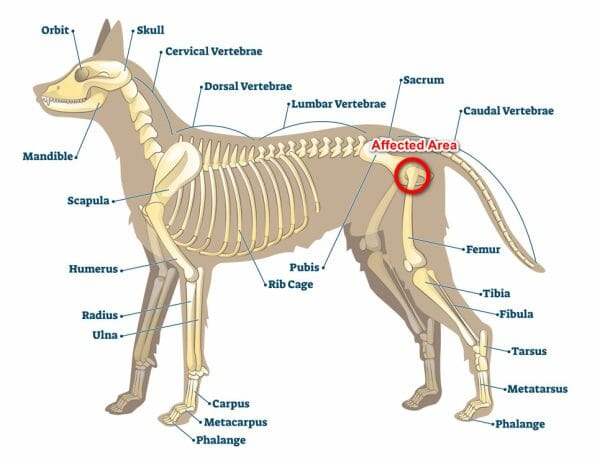What Is Calve Legg Perthes Disease in Dogs?
Legg Calve Perthes disease in dogs is sometimes referred to as LCPD, Coxa Plana, Legg-Perthes disease, Perthes disease, and aseptic necrosis of the femoral head. Regardless of the name, Legg Calve Perthes disease is an orthopedic disease affecting the top of the dog’s femur leg bone.
LCPD results in a painful hip condition. A poor supply of blood to the “ball” of the hip will cause the femoral head to spontaneously degenerate and the bone will collapse and die. The disease will lead to the dog developing stiffness in the hip joint along with a limp. Arthritis will soon follow.
The disease is known to cause lameness in dogs, particularly in smaller breeds. The disease usually affects just one hip. However, in very rare circumstances, it may affect both sides.
The disease takes its name from Arthur Legg, Jacques Calve, and Georg Perthes—the orthopedic surgeons that first identified it during the early 1900s.

Legg Calve Perthes Disease in Dogs Symptoms
Legg Calve Perthes disease symptoms in dogs include:
- A limp or lameness that worsens over time
- The canine licking or chewing the skin surrounding the hip
- Stiffness in one or both of the dog’s hind legs
- Muscle atrophy in the affected hind leg
- A change in behavior due to pain (g., anxiety, lethargy, aggression, restlessness, or reclusiveness)
- Pain when the hip joint is moved
- A popping or grating sound (crepitus) when manipulating the joint
Many of the symptoms of LCPD are similar to other orthopedic conditions, such as hip dysplasia.

Causes of Legg Calve Perthes Disease
The exact cause of LCPD is still unknown. However, many believe that the disease develops when the synovial vessels supplying the femoral head are compromised. When blood does not flow to the femoral head, it will cause the bone and cartilage to die. This then causes underdevelopment and weakness in the affected area. When the femoral head of a dog with LCPD deteriorates, it may fracture or completely collapse spontaneously. This may occur while the dog is going about its normal activities.
Which Dogs Suffer From Legg Calves Perthes Disease?
LCPD can affect a broad range of dogs, particularly toy breeds and terriers. The following dog breeds tend to have a predisposition to the condition:
- Yorkshire Terrier
- Cairn Terrier
- West Highland White Terrier
- Manchester Terrier
- Scottish Terrier
- Miniature Pinscher
- Miniature Schnauzer
- Toy Poodle
- Pug
- American Eskimo Dog
- Bichon Frise
- Boston Terrier
- Chihuahua
- Dachshund
- Jack Russell Terrier
- Lakeland Terrier
- Pekingese
- Pomeranian
- Schipperke
- Silky Terrier
- Welsh Terrier

Can a Puppy Have Legg Calve Perthes Disease in Dogs?
Typically, the disease begins develops to in dogs between the ages 5 to 8 months. However, it can sometimes appear earlier. In very rare cases, there is a chance of Legg Calve Perthes disease in older dogs.
Legg Calve Perthes Disease Stages
LCPD will get progressively worse as time goes on. It will generally start with a mild lameness that worsens over the course of a few weeks to a few months.
As the disease progresses, the stiffness and pain will start to get more noticeable. At this stage, muscle atrophy will occur.
Eventually, the dog will no longer be able to bear any weight on the affected joint. This is because the joint is too weak, and the pain and discomfort becomes too much.

How Is Dog Legg Calve Perthes Disease Diagnosed?
Initially, a veterinarian will carry out a thorough physical examination of the dog to look for clinical signs of the disease.
To fully identify Legg Calve Perthes Disease in dogs, X-ray images will be taken. If the disease is present, the femoral head will show signs of deformity or lysis (a type of destruction) around the femoral neck, as well as parts of the bone where density is lower than usual.
In the X-ray, the head of the femur may appear flattened and moth-eaten. There will also be an increase in the space around the joint.
Legg Calve Perthes Disease in Dogs Treatment
The course of treatment a veterinarian will offer for Legg Calve Perthes disease will vary depending on which stage of the condition the dog has reached. In the first stages, rest and the use of pain medication (such as anti-inflammatory drugs) may be given.
Although this type of conservative treatment will help manage the dog’s lameness, it will not prevent the disease from worsening. If the disease does not worsen at this stage, the dog may have a good prognosis with many comfortable years ahead. To keep these dogs healthy, a healthy diet and regular exercise will be important to ensure the dog does not become obese and put additional strain on the affected joint.

However, the best treatment option for LCPD is surgery. During the surgery, a femoral head and neck excision will be performed by the veterinarian. In this procedure, the disintegrating bone on the joint’s “ball” will be removed.
The Legg Calve Perthes disease in dogs surgery cost may be quite expensive. For this reasons, it is always recommended that owners take out a good pet insurance policy to help cover the costs. However, before purchasing a pet insurance policy, check that the condition is covered.
After surgery, rehabilitation therapy will be required. This will help rebuild the muscles and create a false joint that will replace the dead bone. In cases where the symptoms were mild, the dog may make a rapid recovery. If muscle atrophy was present, additional time may be needed to help rebuild muscle mass. In most cases, where the disease is caught early, a full recovery is possible, and the dog will lead a long and healthy life.
Preventing Legg Calve Perthes Disease
Unfortunately, there is very little that can be done to avoid LCPD. However, it is possible to prevent the symptoms from getting worse by taking the dog to a veterinarian as soon as the first signs appear.
Dogs that have Legg Calve Perthes disease should not be bred and should be neutered or spayed. This will help to prevent the LCPD gene from being passed on to other canines.



